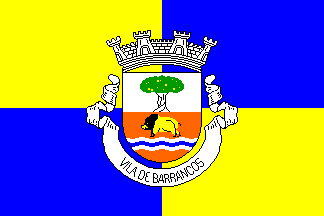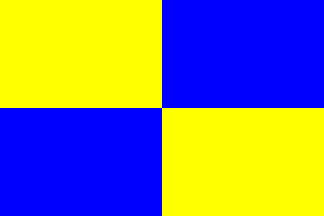
Last modified: 2006-02-05 by antonio martins
Keywords: barrancos | coat of arms | tree: oak: cork | cork | waves: 3 | boar | pig | ham | cereal |
Links: FOTW homepage |
search |
disclaimer and copyright |
write us |
mirrors

The flag is a quartered flag in yellow and blue with the coat of arms,
which is horizontally partitioned in two: above its silver with a cork oak
proper with yellow acorns, below its yellow with three wavy bars in
silver-blue-silver in the lower part and a wild boar proper above it. The
coat of arms is completed with a 4-towered mural crown and a scroll reading
"VILA DE BARRANCOS".
Jorge Candeias, 24 Jan 1999
This coat of arms illustrates the characteristics of the region. The cork
oak stands for the richnesses of the region (produces mostly cattle and cork),
the wavy stripes stand for the Múrtiga Creek or the Ardila River, the two
waterways that cross the municipality (the last one defines the border with
spain for some kms). The yellow field probably also has a meaning related
with cereal.
Jorge Candeias, 24 Jan 1999
The boar stands for the famous Pata Negra ham, the most famous
byproduct of the alentejan black pig! Even more than cork, this is the main
export of this municipality!
António Martins, 25 Jan 1999

Yellow over blue, quartered.
Jorge Candeias, 25 Jul 1999
Barrancos is a town placed very close to spain in the right bench of
Guadiana River. They have their own dialect there, barranquenho,
a mixture of portuguese and castillan, and some local idiossincrasies,
to the point of saying from time to time that they are neither portuguese
nor spanish. The municipality belongs to the district
of Beja, old province of Baixo Alentejo. It
is a small municipality with 168.4 sq.km. and a little over 1900 inhabitants,
only has one commune, and is also a quite poor and rural region.
Jorge Candeias, 24 Jan 1999
According to linguists I’ve read, this is a «portuguese-castillian
contact pidgin» (the order matters, as it is essentially portuguese).
António Martins, 10 Feb 2003